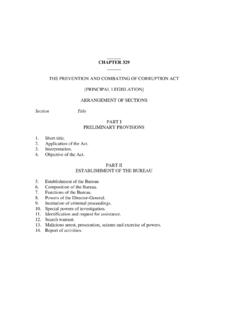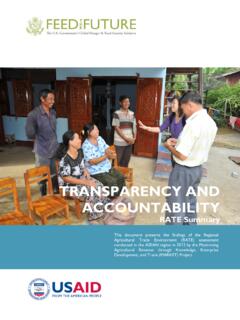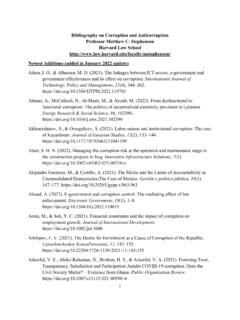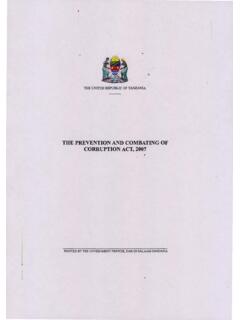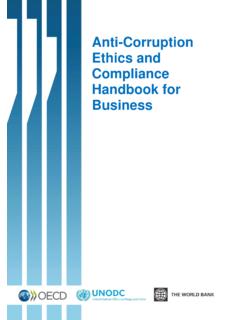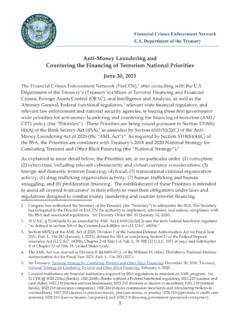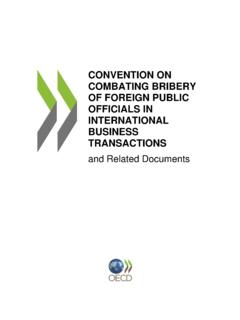Transcription of GRAFT AND CORRUPTION: THE PHILIPPINE EXPERIENCE
1 501113TH INTERNATIONAL TRAINING COURSEPARTICIPANTS PAPERS* Deputy Director / Dean of Academic, PhilippineNational Police Academy, PHILIPPINE Public SafetyCollege, Initiatives Taken Against corruption : ThePhilippine Case ; unpublished paper prepared byLedivina V. Cari o, University Professor and Dean,Gabriele R. Iglesias, Assistant Professor, and V. Mendoza, Associate Professor, College ofPublic Administration, University of AND corruption : THE PHILIPPINE EXPERIENCEN elson Nogot Moratalla*I.
2 INTRODUCTIONThis paper will present a condensedreport on GRAFT and corruption in thePhilippines. Information was compiled bythe author from documents, articles,newspaper clippings and other datagathered from the reports and journals ofthe Ombudsman and the Sandiganbayan,two of the constitutional bodies mandatedby PHILIPPINE law to investigate and act oncomplaints filed against public officials andemployees for violations of GRAFT andcorrupt practices. More specifically, thisreport will cover input from an unpublishedresearch paper prepared by scholars fromthe University of the Philippines, Collegeof Public Administration, whom I willaccordingly acknowledge in this report will generally follow theoutline as provided.
3 The first portion willintroduce the theoretical perspective andcontext of corruption in the Philippines. Itclarifies the national context within whichcorruption operates. It will look into theintersection of corruption and Philippinehistory and culture. It will likewise discusssome public perceptions of of the extent and losses ofcorruption in the Philippines will be brieflydiscussed. The history of the Philippinefight against corruption will be taken upin terms of law, anti-corruptionconstitutional bodies, and othergovernment agencies and non-governmentinitiatives.
4 Finally, there will be anassessment of the anti- GRAFT and corruptionprograms, and recommendations on whatmight be done in the light of Philippinedemocracy, culture and THEORETICAL PERSPECTIVEWe view corruption as an agent sdeparture from the principal s demand forthe responsible use of power in society. Assuch, although it is centered on a publicofficial s act and is indicated by a violationof law, it does not involve the state , it is embroiled in the accountabilityof public officials, and indeed of the state,to the people.
5 Thus, in analyzing andcombating corruption , we look beyond thestate. corruption shows up what thesociety views as the responsible use ofpower and thus what it will accept andsupport. In this light, any attack againstcorruption must come to terms not onlywith the law, but also with the country shistory, ie what is accepted by the cultureand the behavior of civil society as THE CONTEXT OFCORRUPTION IN THEPHILIPPINESIn the late 1980 s, the Philippinesentered the Guinness Book of WorldRecords for allegedly the biggest corruptionof all time, referring to the period of thedictatorship of the former President,2 Ibid, Initiatives Taken Against corruption .
6 ThePhilippines Case ; MATERIAL SERIES No. 56 Ferdinand Marcos. Marcos was oustedfrom his twenty-year presidency by abloodless people s power revolution inFebruary 1986. To describe the corruptionof his regime, kleptocracy and plunder became part of the Filipino s politicalvocabulary and Governmentby thievery did not stop with theenactment of the Republic Act No. 7080 in1991, entitled An Act Defining Plunder .Indeed, although both laws and agenciesto combat corruption have increased in thepost-Marcos period, it remains one of theprime problems complained of by thepeople.
7 The currency and gravity of theproblem are manifested in the followingclippings from a September 7, 1998 issueof the PHILIPPINE Daily Inquirer: On board a PHILIPPINE Airlineschartered flight to Manila fromMindanao where he inspected on-going government infrastructureprojects, President Joseph thought of a sloganreminding Filipinos that he is seriousin fighting GRAFT and corruption in thegovernment. Dubbed Supilin, pigilinang pagnanakaw sa pamahalaan, ( Win over, stop thievery ingovernment ), he thought of putting-up such a message on billboards, hugeposters and the like to remind peoplein government and the private sectornot to succumb to the evils of stealingfrom government coffers.
8 Stealing,if aggregated with othermisdemeanors of public service andtheir transactees, he said, wouldsum up to about 20 percent of thenational budget. With a proposedbudget of more than 500 billion in1999, this means roughly 100 billionpesos will go to waste if corruptionremains unchecked. While the figure cited above is a ballparkfigure that cannot be validated, the concernof President Estrada is certainly warrantedby the findings of this research. It is alsonot a recent phenomenon but one that hasbeen identified and decried since theSpanish colonization in the 16th Filipino Culture and CorruptionCorruption has been viewed as a cultural and psychological phenomenon ina country marked by incompatible legal andcultural norms (Tapales 1995:407).
9 Theformer emphasizes rationality anduniversal principles of action as againstand in conflict with reliance and obligationtoward kinship, friendship and primarygroups (Bautista 1982). This conflict ishighlighted in the use of the alibi of a gift-giving culture to justify bribery andextortion, or the Filipino regard for theother (pakikipagkapwa-tao) to justifygiving benefits to unqualified butpersonally known is a real problem, but it can beoverblown. For instance, both culture andlaw similarly define cases of corruption andrectitude.
10 One s kin may ostracize abureaucrat who chooses to stay within thelaw. The state may, however, leave themalone, provided they do not compromisetheir official role. Another case is when anofficial participates in a decision involvingkin, even if they vote against that person sinterest, that official (under the RepublicAct 3019) can still be charged withcorruption. For an official similarlysituated, but who bends over backwards tomake sure their kin gets a prizedgovernment contract engages in so called favour corruption .
